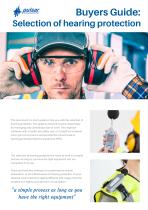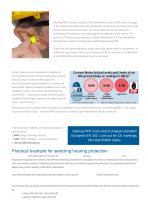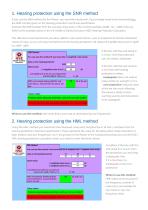
Excertos do catálogo

Buyers Guide: Selection of hearing protection This document is a short guide to help you with the selection of hearing protection. The guide is aimed at anyone responsible for managing and controlling noise at work. This might be someone with a health and safety role, or it might be someone who's job it is to procure and provide the correct level of hearing personal protective equipment (PPE). The selection of hearing protection for noise at work is a simple process as long as you have the right equipment and are competent in its use. There are three key methods for predicting the overall attenuation, or the effectiveness of hearing protection, at your disposal. Each method is slightly different and ranges from the simplest to a highly accurate form of calculation. "a simple process as long as you have the right equipment"
Abrir o catálogo na página 1
Hearing PPE consists mostly of ear defenders (or ear muffs) and ear plugs. In the case of ear defenders the protection comes from acoustic foam that covers and surrounds the ears. The foam absorbs sound energy by increasing air resistance and reducing the amplitude of the waves. The process of losing sound energy is called attenuation. It is the attenuation data that you need to look at when selecting hearing PPE. There are also attenuating ear plugs that offer good levels of protection. In extremely high noise areas (e.g. for ground staff on airports) a combination of ear defenders and ear...
Abrir o catálogo na página 2
1. Hearing protection using the SNR method If you use the SNR method for the Planer, you need the measured LCeq (average noise level measured) plus the SNR number given on the hearing protection's technical specification. Subtract the SNR number from the average noise level. In this worked example: 90dB - 19 = 71dB at the ear. Refer to the example below in the UK Health & Safety Executive (HSE) Hearing Protection Calculator. The HSE also recommends that you allow 4dB for 'real-world' factors, such as imperfect fit and the directional nature of noise, so you can assume that the current...
Abrir o catálogo na página 3
3. Hearing protection using Octave Band Analysis For really noisy equipment with measured LAeqs consistently in the mid 90 dB then the best method to use for hearing protection selection is Octave Band Analysis. This method is meant to be the most accurate way of measuring the effectiveness of hearing protection as it is looking at the actual frequencies of noise experienced by a worker. For this, you will need a sound level meter that is capable of measuring noise at octave bands centre frequency (in Hertz (Hz)) such as the Pulsar Nova Model 46 (or Model 44 with Octave bands added). In...
Abrir o catálogo na página 4Todos os catálogos e folhetos técnicos Pulsar Instruments
-
User manual for Nova® sound level meters
61 Páginas
-
Hand-Arm Vibration Meter
4 Páginas
-
SafeEar Noise-Activated Warning Sign
6 Páginas
-
Guide to Controlling Noise at Work
4 Páginas
-
The Quantifier Range of Sound Meters
6 Páginas
-
Pulsar NoisePen noise dosimeter
2 Páginas
-
Assessor Automatic Sound Level Meter
6 Páginas
-
Model 14: Digital Sound Level Meter
2 Páginas
-
Noise Dosemeter - Pulsar doseBadge
4 Páginas
Catálogos arquivados
-
Model 33
4 Páginas
-
The Assessor Range
6 Páginas
-
Entertainment Noise
11 Páginas
-
data logging RTA Sound Level Meter
4 Páginas


























































